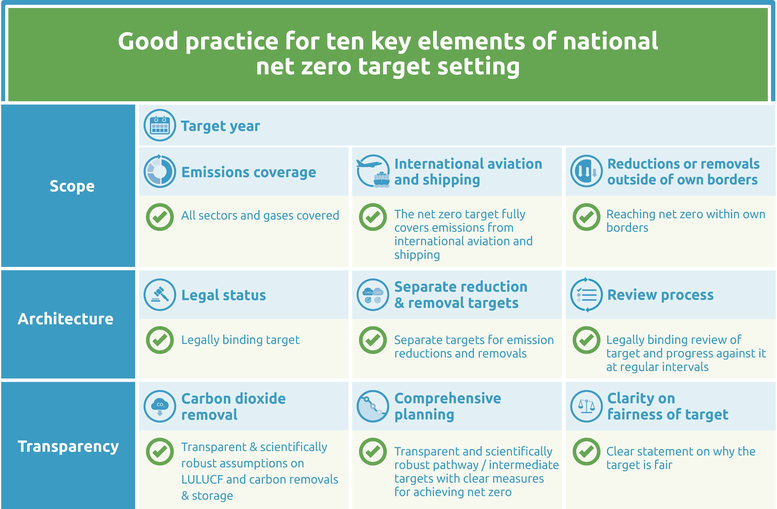Net zero targets
Summary
We evaluate the EU’s net zero target as: Acceptable.
In 2021, the European Union adopted its Climate Law, which enshrines its collective objective of achieving “climate neutrality by 2050.”
The EU’s climate–neutrality - or, essentially, net zero GHG emissions – target is acceptable in terms of its architecture, transparency and scope, with a regular review and assessment process.
There is room for improvement in the target’s scope, as the European Climate Law currently does not clearly state that international aviation and maritime transport emissions are included, and an explanation of why net zero by 2050 constitutes a fair contribution is lacking.
As required under the Climate Law, the Commission has assessed in 2023 the progress of the EU’s climate policy towards meeting its net zero target for the first time (European Commission, 2023a). The Commission found progress to be insufficient. The assessment stresses that all parts of the Fit-for-55 legislative package must be rapidly implemented and that the EU and its member states need to significantly increase the pace of emissions reductions, to almost triple the average annual reduction achieved over the last decade (European Commission, 2023a).
CAT analysis of net zero target
Ten key elements
Scope
- Target year – The EU aims to reach net zero by 2050 at the latest, with net negative emissions thereafter.
- Emissions coverage – The target covers all GHG emissions (i.e., the 7 Kyoto gases: CO2, CH4, N2O, HFCs, PFCs, SF6, NF3) and all sectors of the economy.
- International aviation and maritime transport – The target only covers international aviation. The EU has adopted policies partially covering international maritime emissions, however, this bunker is not covered in its final targets. Both international aviation and maritime emissions are not clearly mentioned in the European Climate Law.
- Reductions or removals outside of own borders – The EU plans to reach net zero through domestic actions and will not use removals outside its borders. The European Climate Law states that the balance between emissions and removals is to be achieved domestically.
Target architecture
- Legal status – The EU passed its net zero target into law with its European Climate Law in 2021 (European Parliament and the Council of the European Union, 2021). The net zero target is further included in the EU’s LTS submitted to the UNFCCC in 2020 (Croatian Presidency and the European Commission, 2020)
- Separate reduction & removal targets – The EU does not provide separate emission reduction and removal targets as part of its net zero target. However, in its latest proposal for 2040 targets to achieve net zero emission by 2050, it highlighted separate information on emission and removal pathways but this is yet to be adopted as a target (European Commission, 2024b).
- Review process – The EU has a legally binding process in place to review the net zero target itself. The EU Climate Law includes a legally binding process for the Commission to report on the operation of the regulation within six months of each Global Stocktake (Article 9a). When it does so, the Commission may include proposals for amendments to the regulation. There is also a provision on the tracking of collective progress of the EU towards the achievement of net zero (Article 5), every five years.
Transparency
- Carbon dioxide removal – The EU provides transparent pathways for LULUCF and separately for removals and storage. In the Commission’s impact assessment of 2040 targets, pathways for LULUCF and industrial removal across sectors are modelled between 2030 and 2050 (European Commission, 2018c, 2024b).
- Comprehensive planning – The Climate Law has set an intermediate target of a GHG emissions reduction of 55% by 2030 (below 1990 levels). The Commission is in the process of passing 2040 target based on projected emissions budget for 2030-2050. The Commission’s underlying analysis for the climate neutrality strategy identifies clear pathways and key measures for reaching net zero, with sector-specific detail, under four different scenarios.
- Clarity on fairness of target – The EU refers to the social fairness of the appropriate measures and fairness between EU Member States but makes no reference to global fairness or equity in the context of its net zero target. In its 2040 target communication, the commission makes reference to climate diplomacy and partnerships to encourage global decarbonisation but does not provide detail on what fair share elements it considers (European Commission, 2024c).
Good practice
The Climate Action Tracker has defined the following good practice for all ten key elements of net zero targets. Countries can refer to this good practice to design or enhance their net zero targets.
Further analysis
Latest publications
Stay informed
Subscribe to our newsletter





